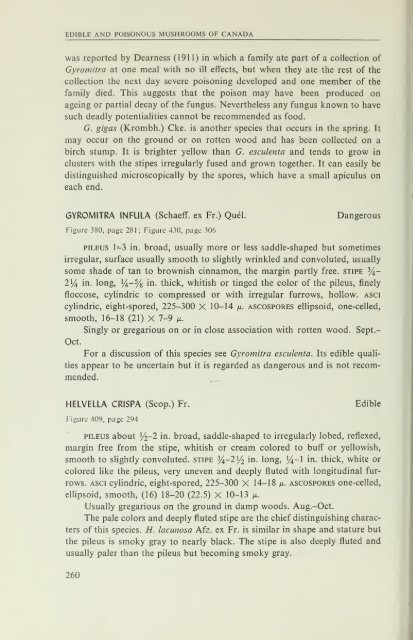You also want an ePaper? Increase the reach of your titles
YUMPU automatically turns print PDFs into web optimized ePapers that Google loves.
EDIBLE AND POISONOUS MUSHROOMS OF CANADA<br />
was reported by Dearness (191 1) in which a family ate part of a collection of<br />
Gyromitra at one meal with no ill effects, but when they ate the rest of the<br />
collection the next day severe poisoning developed and one member of the<br />
family died. This suggests that the poison may have been produced on<br />
ageing or partial decay of the fungus. Nevertheless any fungus known to have<br />
such deadly potentialities cannot be recommended as food.<br />
G. gigas (Krombh.) Cke. is another species that occurs in the spring. It<br />
may occur on the ground or on rotten wood and has been collected on a<br />
birch stump. It is brighter yellow than G. esculenta and tends to grow in<br />
clusters with the stipes irregularly fused and grown together. It can easily be<br />
distinguished microscopically by the spores, which have a small apiculus on<br />
each end.<br />
GYROMITRA INFULA (Schaeff. ex Fr.) Quel. Dangerous<br />
Figure 380, page 281 ; Figure 430, page 306<br />
PILEUS 1-3 in. broad, usually more or less saddle-shaped but sometimes<br />
irregular, surface usually smooth to sHghtly wrinkled and convoluted, usually<br />
some shade of tan to brownish cinnamon, the margin partly free, stipe %-<br />
2]4 in. long, |4-% ii^- thick, whitish or tinged the color of the pileus, finely<br />
floccose, cylindric to compressed or with irregular furrows, hollow, asci<br />
cylindric, eight-spored, 225-300 X 10-14 }x. ascospores ellipsoid, one-celled,<br />
smooth, 16-18 (21) X 7-9 /x-<br />
Oct.<br />
Singly or gregarious on or in close association with rotten wood. Sept.-<br />
For a discussion of this species see Gyromitra esculenta. Its edible quali-<br />
ties appear to be uncertain but it is regarded as dangerous and is not recom-<br />
mended.<br />
HELVELLA CRISPA (Scop.) Fr. Edible<br />
Figure 409, page 294<br />
PILEUS about Yi-l in. broad, saddle-shaped to irregularly lobed, reflexed,<br />
margin free from the stipe, whitish or cream colored to buff or yellowish,<br />
smooth to sHghtly convoluted, stipe %-2j^ in. long, y^-\ in. thick, white or<br />
colored Hke the pileus, very uneven and deeply fluted with longitudinal fur-<br />
rows. ASCI cyHndric, eight-spored, 225-300 X 14-18 /x. ascospores one-celled,<br />
ellipsoid, smooth, (16) 18-20 (22.5) X 10-13 /z.<br />
Usually gregarious on the ground in damp woods. Aug.-Oct.<br />
The pale colors and deeply fluted stipe are the chief distinguishing charac-<br />
ters of this species. H. lacunosa Afz. ex Fr. is similar in shape and stature but<br />
the pileus is smoky gray to nearly black. The stipe is also deeply fluted and<br />
usually paler than the pileus but becoming smoky gray.<br />
260

















